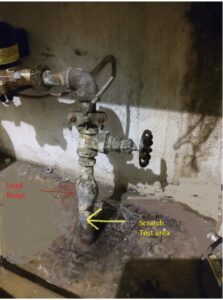LEAD Water Contamination
The most common sources of lead water contamination are lead pipes that carry drinking water from the water source to the home or business, lead faucets, and lead plumbing fixtures (such as solder 50/50, instead of lead-free, and lead pipe fittings).
In 1986 Congress amended the Safe Water Drinking Act which prohibited the use of lead in pipes, solder or flux in relation to all potable water.
Potential Health Effects of Lead (Children are more at risk than adults):
- Reduced intelligence.
- Impaired hearing & decreased growth in children.
- Damage to the brain, kidneys, & bone marrow.
- Damage to the central nervous system & red blood cells.
 How to determine your water service line material:
How to determine your water service line material:
- Look for bulge (called a lead wipe) where the lead pipe connects to a valve or fitting. A bulge is a telltale sign that the pipe is made of lead.
- Still unsure? Scratch the pipe. If the area scratched is a shiny silver color, it is lead. If the pipe remains a dull gray color, the pipe is probably made of steel.
- Another test is to use a magnet. A magnet will not stick to a lead pipe, but it will to galvanized or steel.
Lead can be removed from water through reverse osmosis, activated carbon filtration, and distillation (least common). It can also be removed by identifying and replacing all the lead pipes and plumbing fixtures. Most systems need to be certified by NSF or WQA Gold Seal as a Complete System. These systems include all components, housings, piping, media or filters rather than an individual certified filter, which gets put into a housing.





